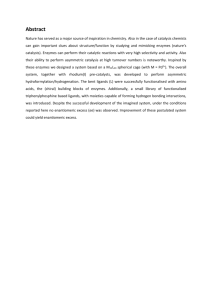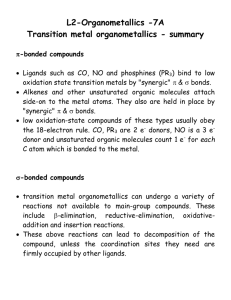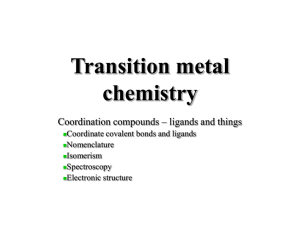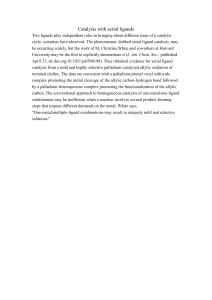Chapter 3 Rhodium-diphosphite catalysed hydroformylation of allylbenzene and propenylbenzene derivatives
advertisement
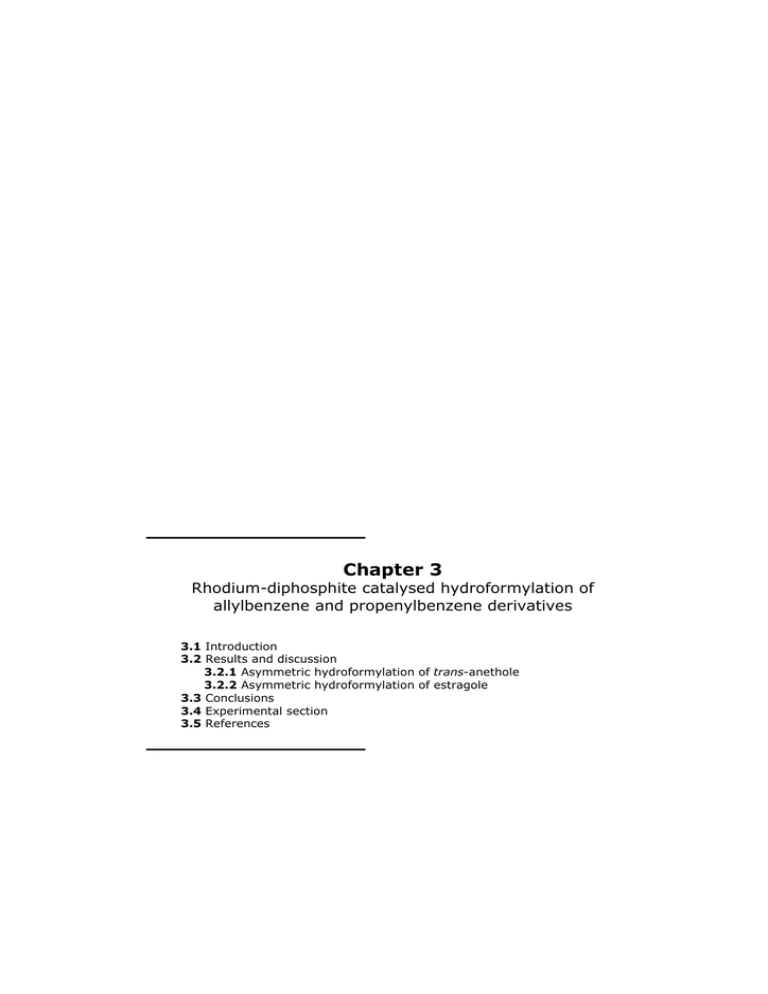
Chapter 3 Rhodium-diphosphite catalysed hydroformylation of allylbenzene and propenylbenzene derivatives 3.1 Introduction 3.2 Results and discussion 3.2.1 Asymmetric hydroformylation of trans-anethole 3.2.2 Asymmetric hydroformylation of estragole 3.3 Conclusions 3.4 Experimental section 3.5 References Abstract. The asymmetric hydroformylation of allylbenzenes and propenylbenzenes is an important tool for obtaining high value intermediates for the pharmaceutical and perfume industry. We have studied these reactions with rhodium-chiral diphosphite systems. The diphosphite ligands 6 and 7 with carbohydrate backbone have high regioselectivities in trans-anethole hydroformylation and moderate ones in estragole hydroformylation. Only low enantioselectivities have been observed in the trans-anethole hydroformylation with the rhodium-diphosphite 6 based system. Hydroformylation of allylbenzenes and propenylbenzenes 3.1 Introduction The asymmetric hydroformylation reaction is an important tool for synthesizing enantiomerically pure aldehydes. These are important precursors of biologically pure compounds, biodegradable polymers and liquid crystals.[1-3] On the other hand, the hydroformylation of terpenes makes it possible to produce aldehydes of interest to the perfume industry (Scheme 3.1).[4-8] H2/CO + + CHO CHO limonene CHO H2/CO CHO a-pinene H2/CO ß-pinene H2/CO H2/CO OH OH OAc OAc CHO (-) isopulegol CHO isopulegyl acetate Scheme 3.1. Hydroformylation of some terpenes The hydroformylation of terpenes such as eugenol, safrole and estragol, which are allylbenzenes, and their isomers isoeugenol, isosafrole and trans-anethole, which are propenylbenzenes (Figure 3.1) is interesting for the formation of aldehyde derivatives for the flavour industry.[8] Although asymmetric hydroformylation of vinylaromatic compounds has been widely studied[1-3, 9] there are very few studies on the hydroformylation of allylbenzenes and propenylbenzenes.[10-13] carbohydrate derivative ligands & catalysis & nanoparticles 103 Chapter 3 HO MeO O O OMe eugenol estragole safrole HO MeO O O OMe isoeugenol isosafrole trans-anethole Figure 3.1. Allylbenzenes and propenylbenzenes The hydroformylation of propenylbenzenes 1 (Scheme 3.2) makes it possible to synthesize two branched aldehydes 3 and 4, but the isomerisation of these olefins to the terminal alkenes 2, allylbenzenes, also leads to the formation of the branched and linear aldehydes 4 and 5, respectively. O H2/CO H2 R1 H * * + R1 R1 R2 R2 1 3 H O R2 4 isomerisation R1 H2 R2 R1 + R1 R1 H R2 R2 2 4 R2 H * H2/CO O O R1 R2 5 compound compound OCH3 H 1a trans-anethol 2a estragole OH OCH3 1b isoeugenol 2b eugenol 1c isosafrol 2c safrole -OCH2O- Scheme 3.2. Hydroformylation of allylbenzene and propenylbenzene 104 carbohydrate derivative ligands & catalysis & nanoparticles Hydroformylation of allylbenzenes and propenylbenzenes The hydroformylation of eugenol 2b and isoeugenol 1b with unmodified rhodium catalysts at very high pressures was studied 25 years ago.[10] A mixture of aldehydes 3, 4 and 5 was obtained (Scheme 3.2). Temperature was observed to have a strong influence on the regioselectivity. At low temperature (70ºC), the ratio of aldehydes obtained from 1b and from 2b was very different, while at 130ºC the ratios were closer. This indicates that an isomerization process takes place when the temperature increases, so the process is less selective (Table 3.1). Kalck et al.[11] reported high selectivities for linear aldehydes 5 when they used the catalytic system [Rh2(µ-SR)2(CO)2L2] (L: PPh3, P(OMe)3 and P(OPh)3) in the hydroformylation of allylbenzenes (estragole 1c, eugenol 2b, eugenol methyl ether and safrole 3c) Table 3.1. Hydroformylation of isoeugenol 1b and eugenol 2b by [Rh(Cl)(COD)]2a [10] Substrate 1b 2b Temperature 3 b (α α) 4 b (β β) 5 b (γγ) 3 b (α α) 4 b (β β) 5 b (γγ) 70 95 5 0 0 48 52 80 90 10 0 3 45 52 100 50 45 5 11 37 52 40 50 10 41 24 35 130 a Reaction conditions: 20 ppm [Rh(Cl)(COD)]2 , 600 bar (CO/H2=1/1) The asymmetric hydroformylation of trans-anethole 1a and estragole 2a was studied by Kollár[12] using PtCl2(bdpp)+SnCl2 (bdpp=(2,4-bis-diphenylphosphino) pentane) and [Rh(nbd)Cl]2+L (nbd= norbornadiene, L: PPh3 or DIOP) catalytic systems. The regioselectivities with the platinum system were low and were improved when rhodium systems were used. The enantioselectivity observed was low in the hydroformylation of trans-anethol 1a and estragole 2a with both systems. With PtCl2(bdpp)+SnCl2 and DIOP as the ligand, the regioselectivity to the branched aldehdyde 3a was a 53% and with an enantioselectivity of 27.5%. Dos Santos et al.[13] reported the hydroformylation of various allylbenzenes and propenylbenzenes with rhodium-based systems. They studied the electronic and steric effects of the ligands on the final distribution of the aldehydes and they found that, when monodentate ligands were used, the regioselectivity depended on the carbohydrate derivative ligands & catalysis & nanoparticles 105 Chapter 3 basicity of the ligand. Thus, in the hydroformylation of eugenol 2b with the Rh/P(OPh)3 catalytic system, isomerisation to the internal olefin was observed, but when the reaction was driven in the presence of PPh3 it was not. However, the use of more basic phosphines, such as P(Cy)3 and P(n-Bu)3, decreased the activity and the regioselectivity to the linear aldehyde. The activity of the less basic ligands is higher because the electron-withdrawing ligands decreased the back-donation to carbon monoxide and thus weakened the binding of the carbonyls. This favours the dissociation of carbon monoxide because it increases the reaction rate.[3] The effect of the basicity of the monodentate ligand on the regioselectivity could be explained by the basicity of the hydride. A basic phosphine leads to an increase in the nucleophilicty of the hydride. Therefore the interaction of the hydride with the terminal carbon (which bears a more positive fractional charge than the β-carbon) is favoured leading to amounts of branched aldehyde 4a.[13] Table 3.2. Hydroformylation of eugenol 2b by [Rh(COD)(OAc)]2/diphosphine system.a[13] Bite Time Conv.c angle (º) (h) (%) dppe 85 24 dppp 91 dppb 98 BISBI NAPHOS Diphosphineb a 5/4 4 (β β) 5 (γγ) 55 62 38 0.6 24 74 69 31 0.5 24 99 34 66 1.9 123 7 81 2 98 49.0 120 7 90 2 98 49.0 (γ/β γ/β) γ/β Reaction conditions: substrate (10.0 mmol), [Rh(COD)(OAc)]2 (0.005 mmol), diphosphine (0.20 mmol), benzene bis(diphenylphosphino)ethane; bis(diphenylphosphino)butane, (40 ml), 2Mpa (CO/H2=1/1), 80ºC. dppp:1,3-bis(diphenylphosphino)propane; NAPHOS: b dppe:1,2- dppb: 1,4- 2,2’-bis[(diphenylphosphino)methyl]-1,1’-binaphthyl; BISBI: 2,2’-bis[(diphenylphosphino)methyl]-1,1’-biphenyl.c Determined by GC; hydrogenated substrate is detected in trace amounts. When diphosphine-based systems (dppe, dppb, BISBI and NAPHOS) were used, the bite angle of the diphosphine and the regioselectivity were related (Table 3.2). Thus, it can be observed that ligands with big bite angles (BISBI and NAPHOS) afforded the linear aldehyde almost exclusively, while for ligands with small bite angles (dppe, dppp) the regioselectivity for the linear aldehyde decreased dramatically (<40%). This behaviour has been attributed to the coordination mode of these ligands. In the trigonal-bipyramidal rhodium-hydride species, the ligands 106 carbohydrate derivative ligands & catalysis & nanoparticles Hydroformylation of allylbenzenes and propenylbenzenes with small bite angles coordinate in apical-equatorial positions giving more basicity to the hydride (trans to a P ligand) than the diphosphines with major bite angle (around 120º) that coordinates in equatorial-equatorial mode. The greater basicity of the hydride makes it possible to obtain greater amounts of the branched aldehyde because the favoured interaction of the hydride with the terminal carbon. This effect has already been studied in the hydroformylation of 1-alkenes.[14] Although it is usually accepted that the influence of the bite angle on the regioselectivity is related to electronic effects, steric factors cannot be ignored. In spite of the numerous studies on the correlation between the bite angle and the regioselectivity, this relationship has yet to be clarified.[15-19] It is known that the hydroformylation rate of propenylbenzes is lower than that of allylbenzenes. The rate determining step in the hydroformylation reaction is usually the coordination of the alkene, and because the internal alkenes are more hindered their coordination is more disfavoured than the terminal alkenes. With unmodified rhodium systems, the regioselectivities depend on temperature and pressure. At high temperature, isomerisation increases because β-elimination is favoured.[3] The increase in the partial pressure of carbon monoxide (CO/H2=2/1) led to a slight decrease in the activity and did not affect the regioselectivity. As in the case of allylbenzenes, when diphosphine ligands were studied, the nature of the ligand was also seen to depend on the regioselectivity. Thus, NAPHOS with a larger bite angle provided regioselectivities over 90% to the α-aldehyde (3), while dppp showed regioselectivities around 70% in this isomer. O O O P O O P O O O O O OTBDPS O P O O 6 O P O tBu But O TBDPSO O = O But R1= tBu OO tBu R2= tBu 7 Figure 3.2. Diphosphite chiral ligands with a carbohydrate backbone Chiral diphosphite ligands have been widely used in asymmetric hydroformylation and they have shown good activities, regioselectivities and enantioselectivities.[9] carbohydrate derivative ligands & catalysis & nanoparticles 107 Chapter 3 However, they have not been used in the hydroformylation of allylbenzenes and propenylbenzenes. In this context, we decided to study the hydroformylation of trans-anethole 1a and estragole 2a with a rhodium catalyst modified with diphosphite chiral ligands 6[20] and 7[21] (Figure 3.2). Diphosphite ligand 6 has C1symmetry and three carbons between the phosphorus moieties, which forms an eight-member chelate ring. However, ligand 7 has C2-symmetry with two carbons in the bridge between the phosphorus atoms, which forms a seven-member chelate ring. These ligands have been previously used in the rhodium-catalysed hydroformylation of styrene and have shown high regioselectivities to branched aldehyde and moderate enantioselectivities (95% and 40%(S), respectively, for ligand 6, and 97% and 46%(S), respectively, for ligand 7). It is to be expected that the higher substitution of the double bond in trans-anethole will produce a change in the regioselectivity and stereoselectivity of the process. 3.2 Results and discussion 3.2.1 Asymmetric hydroformylation of trans-anethol 1a (propenybenzene) We studied the hydroformylation of trans-anethole 1a with a rhodium-based system (Scheme 3.2). Unlike styrene, the model substrate in asymmetric hydroformylation, this substrate is an internal olefin. The trans-anethole 1a needs more drastic conditions of reaction than the styrene, and two branched aldehydes 3a and 4a could be obtained with the formyl group in α- or β-positions, respectively. If 1a isomerises to estragole 2a, the hydroformylation of 2a will lead to the formation of two aldehydes: the branched β-isomer 4a and the linear aldehyde 5a. The trans-anethole was hydroformylated by an in situ formed catalyst, by adding diphosphite ligands 6 or 7 to a solution of the rhodium precursor ([Rh(acac)(CO)2]). The results are summarised in Table 3.3. The Rh/6 catalytic system gives a higher conversion than when no ligand or PPh3 were used, while the selectivity in isomer 3a was lower than in the presence of PPh3 and higher than in the absence of ligand (Table 3.3, entries 1, 2, 3). 108 carbohydrate derivative ligands & catalysis & nanoparticles Hydroformylation of allylbenzenes and propenylbenzenes Increasing the reaction temperature from 60 to 80 ºC (Table 3.3, entry 3 vs. 4) produces no significant changes in the isomerisation, a small increase in the conversion but a considerable decrease in the selectivity of 3a. Similar behaviour was observed by Dos Santos et al.[13] in the hydroformylation of propenylbenzenes with an unmodified rhodium catalyst. This effect is general in hydroformylation and has been observed in other substrates. It is a consequence of the increase in the βelimination rate when the temperature increases.[3] Table 3.3. Hydroformylation of trans-anethole 1a with the Rh/6 and Rh/7 catalytic system.a O H H * * H2/CO MeO Rh MeO 1a Entry Rh/L/S L + + MeO H O O MeO 4a 3a T P CO P H2 (ºC) (atm) (atm) % conv ald.b 5a product % isom.b distribution (%)b 3a 4a 5a (α α) (β β) (γγ) %ee 3a (α α)b %ee 4a (β β )b 1 1/-/200 - 60 20 20 56 5 68 30 2 - - 2 1/4/200 PPh3 60 20 20 18 6 >99 <1 0 - - 3 1/1/200 6 60 20 20 87 2 81 19 <1 0 0 4 1/1/444 6 80 20 20 92 4 66 31 3 0 0 5 1/2/200 6 60 20 20 84 <1 84 16 <1 0 0 6 1/1/200 6 60 10 20 70 2 68 30 2 0 0 7 1/1/200 6 60 20 40 96 <1 86 14 <1 8 15 8 1/1/200 7 60 20 20 79 8 65 33 3 0 0 9 1/2/200 7 60 20 20 39 5 75 22 3 0 0 a trans- anethole 1.8 mmol, [Rh(acac)(CO)2] 0.009mmol, 10 ml. toluene, reaction time: 24h. b % determined by G.C. hydrogenated substrate is detected in trace amounts. The comparison of the results of the Rh/6 system and the unmodified rhodium system, at the same conditions, revealed that only one equivalent of the ligand was required to maintain the active species coordinated to the ligand. When the carbohydrate derivative ligands & catalysis & nanoparticles 109 Chapter 3 rhodium/diphosphite ratio was 1 or 2 (Table 3.3, entries 3 and 5) the regioselectivity to branched aldehyde 3a was similar (81 and 84 %), while with unmodified rhodium system the regioselectivity is 68% to branched aldehyde 3a (Table 3, entry 1). A decrease in CO partial pressure led to a decrease in the activity and regioselectivity in α-isomer 3a (Table 3.3, entry 6 vs. entry 3). At lower pressures, the CO insertion rate decreases and the β-elimination is favoured, which leads to a higher isomerization.[3] The increase in the hydrogen partial pressure significantly affected the conversion but did not affect the regioselectivity of the reaction (Table 3, entry 7). This suggests that hydrogenolysis is the rate determining step. 100 80 60 40 20 0 0 5 10 15 20 estragole 2a trans-anetol 1a β-ald 4a γ-ald 5a 25 α-ald 3a Figure 3.3. Product distribution versus reaction time diagram of the hydroformylation of trans-anethole 1a with diphosphite 6-rhodium catalyst (T: 60ºC, pressure 35 atm. CO/H2 1:1) Figure 3.3 shows the composition of the reaction mixture during the hydroformylation with the rhodium-diphosphite 6 system. After an induction period of one hour, the formation of aldehydes increases rapidly with a TOF= 17.2h-1 110 carbohydrate derivative ligands & catalysis & nanoparticles Hydroformylation of allylbenzenes and propenylbenzenes (60ºC). This TOF is lower than for the same system in styrene hydroformylation TOF=53 h-1 (40ºC) P=25 bar.[22] The isomerisation is very low (<1%) , and the estragole formed is rapidly hydroformylated. We also studied the hydroformylation of trans-anethole 1a using the Rh/7 catalytic system (Table 3.3, entries 8 and 9). In this case, unlike the rhodium-diphosphite ligand 6 system described above, two equivalents of the diphosphite ligand were necessary to maintain the active species coordinated to ligand. When the rhodium/ligand ratio is 1/1 (Table 3.3, entry 8) the regioselectivity is the same as for the unmodified rhodium system (Table 3.3, entry 1). In fact when the rhodium/ligand ratio is 1/2 (Table 3.3, entry 9), the regioselectivity to the α–isomer 3a increases and the activity is lower than when it is 1/1. This indicates that intermediate rhodium-diphosphite ligand 7 species are less stable than with ligand 6 and require more equivalents of ligands to maintain these species with the ligand coordinated. The results of the two diphosphite ligands, obtained in the same conditions, show that the catalyst based on ligand 6 is more selective in α–aldehyde 3a than diphosphite 7 (Table 3.3, entry 5 vs.9). This could be attributed to the nature of ligand 6, which forms an eight-member chelate ring. Ligand 7, on the other hand, forms a seven-member chelate ring. This correlation has also been observed in the hydroformylation of 1a with diphosphine ligands[13] and it has been explained above. 3.2.2 Asymmetric hydroformylation of estragol 2a (allylbenzene) Next we carried out the asymmetric hydroformylation of estragole 2a. The results are summarised in Table 3.4. The conditions are the same as the employed for the hydroformylation of trans-anethole 1a. In this case, at least four equivalents of ligand were required to prevent the formation of unmodified rhodium species, which are more active but less regioselective. When the rhodium/ligand ratio increases from Rh/L 1/1 to 1/4 carbohydrate derivative ligands & catalysis & nanoparticles 111 Chapter 3 (Table 3.4, entries 2-4) the regioselectivity to the β-aldehyde 4a and γ-aldehyde 5a increases. Table 3.4. Hydroformylation of estragole 2a with the catalytic system Rh/6.a O H H * * H2/CO MeO Rh MeO 2a + + MeO H O O MeO 4a 3a 5a product Entry Rh/L/S L T P CO P H2 (ºC) (atm) (atm) % conv ald.b % distribution (%) isom.b b %ee 3a (α α)b 3a 4a 5a (α α) (β β) (γγ) %ee 4a (β β )b 1 1/4/200 PPh3 60 20 20 53 24 <1 50 50 - - 2 1/1/200 6 60 20 20 83 6.6 45 31 24 0 0 3 1/2/200 6 60 20 20 94 1.5 25 36 39 0 0 4 1/4/200 6 60 20 20 86 6.1 0.0 47 53 0 0 5 1/2/1000 6 60 20 20 87 9.2 47 28 25 0 0 a estragole 1.8 mmol, [Rh(acac)(CO)2] 0.009 mmol, 10 ml. toluene, reaction time: 24h. b % determined by G.C. hydrogenated substrate is detected in trace amounts. The comparison between the catalytic systems Rh/PPh3 and Rh/6 showed that with ligand PPh3 the activity was lower and the regioselectivities were very similar (Table 3.4, entries 1 and 4). The lower activity of the PPh3 ligand is attributed to the fact that the basicity of this ligand is greater than that of the diphosphite ligands. Greater basicity disfavours the dissociation of carbon monoxide and leads to a less active catalyst. The similar regioselectivities shown by these two different systems, Rh/PPh3 and Rh/6, is unexpected if we consider the results reported in the literature. The Rh/PPh3 system showed high regioselectivities for linear aldehydes in the hydroformylation of propenylbenzenes.[13] One explanation for this could be the excess of ligand used. Whereas we used a Rh/L ratio of 1/4 in the study mentioned above, the other results were obtained after using an Rh/L ratio of 1/20 and the regioselectivity to the linear aldehyde 5a was nearly 70%. We also observed that when the rhodium/substrate ratio increased from 1:200 to 1:1000 (Table 3.4, entry 112 carbohydrate derivative ligands & catalysis & nanoparticles Hydroformylation of allylbenzenes and propenylbenzenes 3 and 5), the regioselectivity to the γ–isomer 5a was lower, indicating that the presence of more substrate led to more isomerisation. 3.3 Conclusions The use of rhodium-diphosphite based systems in the hydroformylation of transanethole 1a and estragole 2a has not been reported before. In this study, rhodiumdiphosphite system 6 was used in the hydroformylation of trans-anethole 1a and led to high selectivities to aldehyde 3a (as high as 86%) under mild conditions (60ºC, 40 bar). This is not so different from the diphosphine ligands used before which afforded up to 93% of aldehyde 3a with BISBI ligand. We also observed that our diphosphite 6 based system is more active in this reaction than phosphine ligands in similar reaction conditions. When rhodium-diphosphite 7 was used in the trans-anethole 1a hydroformylation, the regioselectivity was lower than when diphosphite 6 was used. We attributed this to the formation of a seven-seven member chelate ring of diphosphite 7 when it coordinates to the rhodium. On the other hand, in the hydroformylation of this substrate new chiral centers (in aldehydes 3a and 4a) are formed by the introduction of formyl groups. We also studied the asymmetric induction of the two diphosphite chiral ligands 6 and 7 in this reaction. We only observed low enantioselectivities in the case of diphosphite 6 in trans-anethole 1a hydroformylation. In the hydroformylation of estragole 2a, we used rhodium-diphosphite 6 ligand. In this case, regioselectivities to the branched aldehyde 4a were low (47% of 4a and 53% of 5a) when excess of ligand was added. We also investigated the enantioselectivity but we did not observe asymmetric induction in the conditions studied. 3.4 Experimental section General methods All syntheses were performed by standard Schlenk techniques under a nitrogen or argon atmosphere. Diphosphites 6 and 7 were prepared by previously described carbohydrate derivative ligands & catalysis & nanoparticles 113 Chapter 3 methods.[20][23] Solvents were purified by standard procedures. All the other reagents were used as commercially available. Gas chromatographic analyses were run on a Hewlett-Packard HP 5890A instrument (split/splitless injector, J&W Scientific, HP-5, 25 m column, internal diameter 0.25 mm, film thickness 0.33 mm, carrier gas: 150 kPa Ar, F.I.D. detector) equipped with a Hewlett-Packard HP3396 series II integrator. Hydroformylation reactions were carried out in a Parr 450 ml. multiple reaction vessel autoclave. Enantiomeric excesses were measured after oxidation of the aldehydes to the corresponding carboxylic acids on a HewlettPackard HP 5890A gas chromatograph (split/splitless injector, J&W Scientific, Supelco β-DEX 110 (30 m. column, internal diameter 0.25 mm., carrier gas: 100 kPa He, F.I.D. detector). Hydroformylation experiments The catalytic precursors were prepared in a multiple reaction vessel autoclave in a glovebox, by adding the ligands to a solution of [Rh(acac)(CO)2] (0.009 mmol) in toluene (10 ml). Then the substrate was added. After pressurising to the desired pressure with syngas and heating the autoclave to the reaction temperature, the reaction mixture was stirred for 24 h. Then the autoclave was cooled to room temperature and depressurised. The reaction mixture was analysed by gas chromatography. The aldehydes obtained from the hydroformylation were oxidised to carboxylic acids to determine the enantiomeric excess. 3.5 References [1] F. Agbossou, J. F. Carpentier, A. Mortreaux, Chem. Rev. 1995, 95, 2485. [2] M. Beller, B. Cornils, C. D. Frohning, C. W. Kohlpaintner, J. Mol. Catal. A: Chem. 1995, 104, 17. [3] P. W. N. M. van Leeuwen, C. Claver, Rhodium Catalyzed Hydroformylation, Vol. 22, Kluwer Academic, 2000. [4] J. L. F. Monteiro, C. O. Veloso, Top. Catal. 2004, 27, 169. [5] C. M. Foca, H. J. V. Barros, E. N. dos Santos, E. V. Gusevskaya, J. C. Bayon, New J. Chem. 2003, 27, 533. [6] I. Cipres, P. Kalck, D. C. Park, F. Serein-Spirau, J. Mol. Catal. 1991, 66, 399. [7] L. Kollar, G. Bodi, Chirality 1995, 7, 121. 114 carbohydrate derivative ligands & catalysis & nanoparticles Hydroformylation of allylbenzenes and propenylbenzenes [8] A. J. Chalk, in Flavors and Fragances: A World Perspective (Ed.: B. M. Lawrence, Mookherjee, B. D. and Willis, B. J.), Elsevier Science, Amsterdam, 1988. [9] M. Dieguez, O. Pamies, C. Claver, Tetrahedron: Asymmetry 2004, 15, 2113. [10] H. Siegel, W. Himmele, Angew. Chem. Int. Ed. 1980, 19, 178. [11] P. Kalck, D. C. Park, F. Serein, J. Mol. Catal. 1986, 36, 349. [12] L. Kollar, E. Farkas, J. Batiu, J. Mol. Catal. A: Chem. 1997, 115, 283. [13] A. C. da Silva, K. C. B. de Oliveira, E. V. Gusevskaya, E. N. dos Santos, J. Mol. Catal. A: Chem. 2002, 179, 133. [14] P. W. N. M. van Leeuwen, C. P. Casey, G. T. Whiteker, in Chapter 4. Rhodium Catalyzed Hydroformylation, Vol. 22 (Ed.: P. W. N. M. van Leeuwen, Claver, C.), Kluwer Academic Press., Dordrecht, 2000, p. 296. [15] C. P. Casey, G. T. Whiteker, M. G. Melville, L. M. Petrovich, J. A. Gavney, D. R. Powell, J. Am. Chem. Soc. 1992, 114, 5535. [16] M. Kranenburg, Y. E. M. Vanderburgt, P. C. J. Kamer, P. W. N. M. van Leeuwen, K. Goubitz, J. Fraanje, Organometallics 1995, 14, 3081. [17] C. P. Casey, L. M. Petrovich, J. Am. Chem. Soc. 1995, 117, 6007. [18] C. P. Casey, E. L. Paulsen, E. W. Beuttenmueller, B. R. Proft, L. M. Petrovich, B. A. Matter, D. R. Powell, J. Am. Chem. Soc. 1997, 119, 11817. [19] P. Dierkes, P. W. N. M. van Leeuwen, J. Chem. Soc., Dalton Trans. 1999, 1519. [20] G. J. H. Buisman, M. E. Martin, E. J. Vos, A. Klootwijk, P. C. J. Kamer, P. W. N. M. Van Leeuwen, Tetrahedron: Asymmetry 1995, 6, 719. [21] To be published. See Chapter 2. [22] O. Pamies, G. Net, A. Ruiz, C. Claver, Tetrahedron-Asymmetry 2000, 11, 1097. [23] To be published. See Chapter 2. [24] G. J. H. Buisman, P. C. J. Kamer, P. W. N. M. van Leeuwen, Tetrahedron: Asymmetry 1993, 4, 1625. [25] T. Jongsma, M. Fossen, G. Challa, P. W. N. M. van Leeuwen, J. Mol. Catal. 1993, 83, 17. [26] M. Aghmiz, A. Aghmiz, Y. Diaz, A. Masdeu-Bulto, C. Claver, S. Castillon, J. Org. Chem. 2004, 69, 7502. carbohydrate derivative ligands & catalysis & nanoparticles 115
